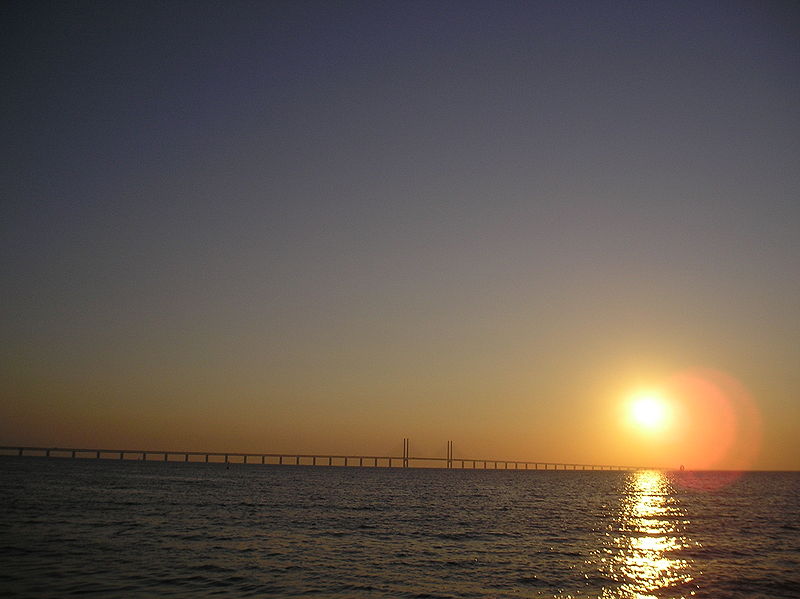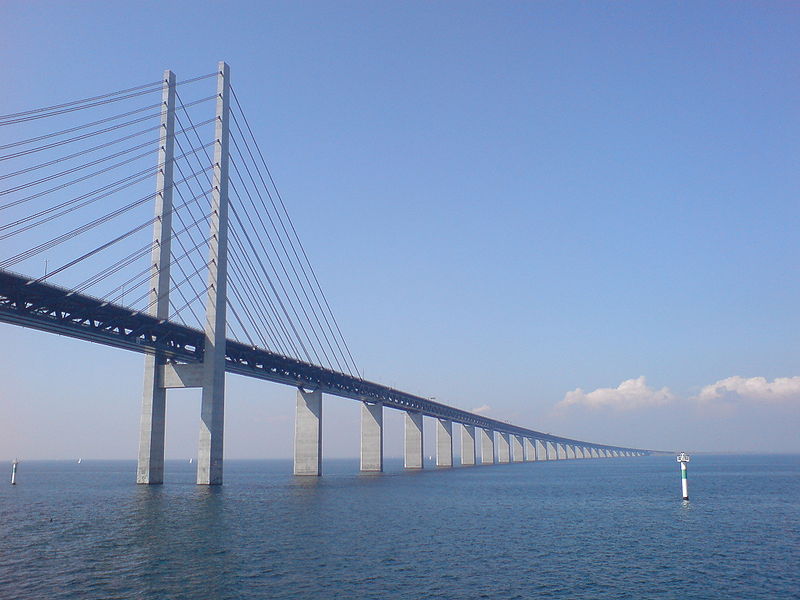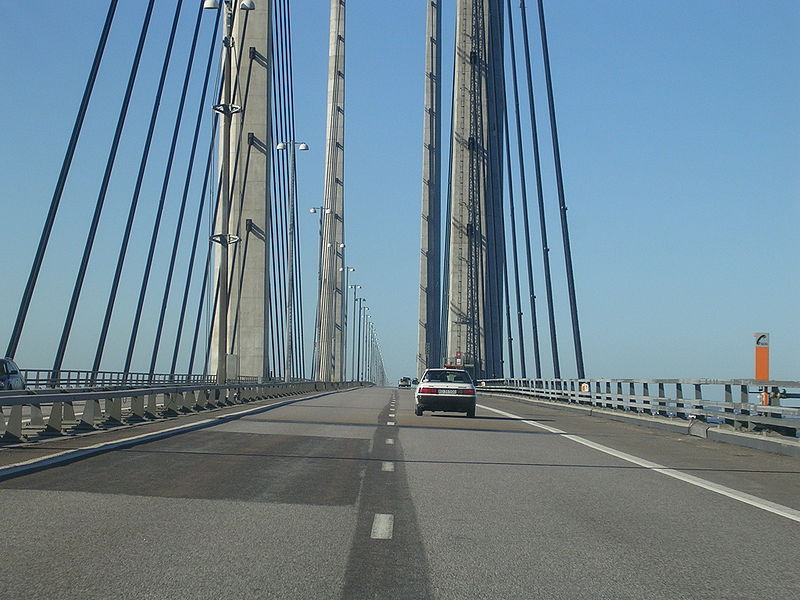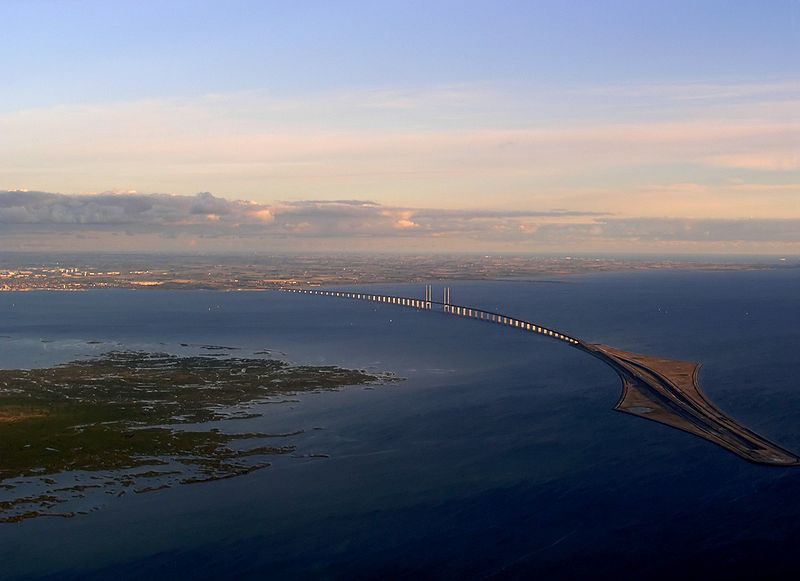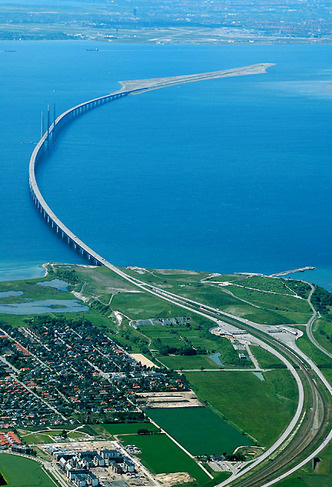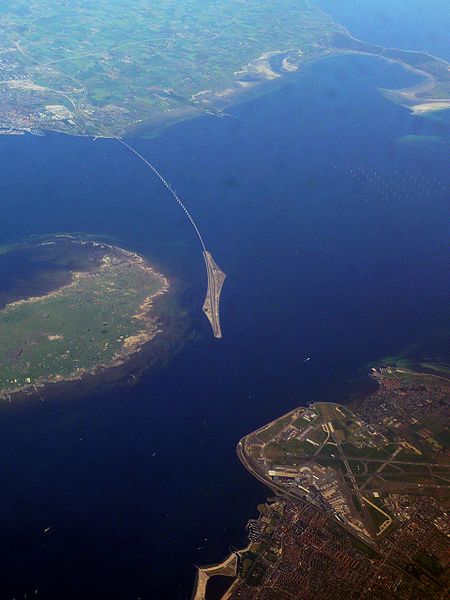| |||||||
Europe
North AmericaSouth AmericaAsiaAustralia and OceaniaAfrica |
Смотрите также: Oresund Bridge The Oresund or Oresund Bridge is a combined two-track rail and four-lane road bridge-tunnel across the Oresund strait. It is the longest combined road and rail bridge in Europe and connects the two metropolitan areas of the Oresund Region: the Danish capital of Copenhagen and the Swedish city of Malmo.
Oresund Bridge Carries 4 lanes of European route E20, Double track Oresund Railway Line Crosses Oresund strait (The Sound) Locale Copenhagen, Denmark and Malmo, Sweden Design Cable-stayed bridge Total length 7,845 metres (25,738 ft) Width 23.5 metres (77.1 ft) Longest span 490 metres (1,608 ft) Clearance below 57 metres (187 ft) Opening date July 2, 2000
The international European route E20 runs across the bridge and through the tunnel via the two lane motorway, as does the Oresund Railway Line. The construction of the Great Belt Fixed Link and the Oresundsbron have, together, enabled one to drive from Mainland Europe to Sweden and the rest of Scandinavia. The bridge was designed by the Danish architectural practice Dissing + Weitling. The Oresundbridge crosses the border between Denmark and Sweden, but thanks to the Schengen Agreement, there are no passport controls. However, there are frequent customs checks at the toll booths on the Swedish side for those entering Sweden, but not for those entering Denmark.
Name In Sweden and Denmark the bridge is most often referred to as Oresundsbron and Oresundsbroen, respectively. The bridge company itself insists on Oresundsbron, a compromise between the two languages. This symbolises a common cultural identity for the region, the people becoming "Oresund citizens" once the bridge is established. Since the crossing actually comprises a bridge, an island, and a tunnel, it is sometimes called, more accurately, the "Oresund Link" or "Oresund Connection". The Sound Bridge is occasionally heard, using the traditional English name for the strait.
History Construction of the crossing began in 1995. It was finished on 14 August 1999. Crown Prince Frederik of Denmark and Crown Princess Victoria of Sweden met midway on the bridge to celebrate the completion. The official inauguration took place on 1 July 2000, with Queen Margrethe II, and King Carl XVI Gustaf as guests of honour. The crossing was opened for public traffic later that day. On 12 June 2000, before the inauguration, 79,871 runners competed in a half marathon (Broloppet, the Bridge Run) from Amager (Denmark) to Skane (Sweden). In spite of two major disasters - 16 unexploded World War II bombs on the sea bed and a skewed tunnel segment - the crossing was finished 3 months ahead of schedule. Initially, the crossing was not used as much as expected, probably because of the high cost. However, 2005 and 2006 saw a rapid increase in traffic. This may have been due to Danes buying homes in Sweden - to take advantage of lower house prices in Malmo - and commuting to work in Denmark. In 2008, to cross by car cost DKK 260, SEK 325 and ? 36.30, although discounts up to 75% are available for regular users. In 2007, almost 25 million people travelled over the bridge: 15.2 million by car and bus, and 9.6 million by train.
Drogden Tunnel Satellite image of the Oresund Bridge.The connection between the artificial island of Peberholm and the artificial peninsula at Kastrup on Amager island - the nearest populated part of Denmark - is through the Drogden Tunnel. The 4,050 m (13,287 ft) long tunnel comprises a 3,510 m (11,516 ft) undersea tube tunnel plus 270 m (886 ft) entry tunnels at each end. The tube tunnel is made from 20 prefabricated, reinforced concrete segments - the most massive in the world at 55,000 tonnes each - interconnected in a trench dug in the seabed. 2 tubes in the tunnel carry railway tracks; 2 more carry roads while a small fifth tube is provided for emergencies. The tubes are arranged side by side. The reason for incurring the additional cost and complexity of building a tunnel instead of another section of bridge, is to avoid obstructing aircraft from nearby Copenhagen Airport and to provide a clear pass for shipping.
Rail transport The public transport by rail product is operated jointly by the Swedish SJ and Danish via DSBFirst on a commission by Skanetrafiken and other county traffic companies (that also sells tickets) and the Danish transport agency. A series of new dual-voltage trains were developed which link the Copenhagen area with Malmo and Southern Sweden as far as Gothenburg and Kalmar on selected departures. SJ operate the X2000 and InterCity trains over the bridge with connections to Gothenburg and Stockholm. DSB operates trains to Ystad that connects directly to a ferry in Bornholm. Copenhagen Airport at Kastrup is served by its own train station close to the western bridgehead. Trains operate every 20 minutes over the crossing and once an hour during the night in both directions. An additional couple of Oresundstrains are operated at rush hour and 1-2 per hour and direction SJ trains and DSB trains every other hour. Freight trains also use the crossing. The rail section is double track standard gauge (1435 mm) and capable of high-speeds up to 200 km/h. Lower in Denmark, especially in the tunnel section. There were challenges related to the difference in electrification and signalling between the Danish and Swedish railway networks. The solution chosen is to switch the electrical system, from Swedish 15 kV, 16.7 Hz to Danish 25 kV, 50 Hz AC right before the eastern bridgehead at Lernacken in Sweden. The line is signalled according to the standard Swedish system across the length of the bridge. On Peberholm, the line switches to Danish signalling which continues into the tunnel. Sweden runs railways with left-hand traffic and Denmark with right-hand traffic. The switch is made at the Malmo Central Station, which is also a terminus. For the new Malmo City Tunnel connection a flyover will pass one track over to the other side. Comments: 0 |
|
|||||









































